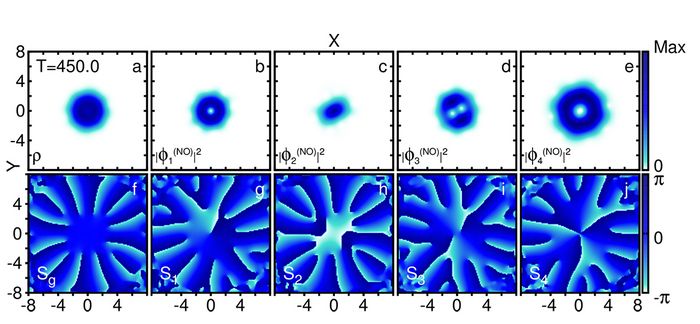MATERIALS SCIENCE AND CHEMISTRY
Project Many-Body Dynamics of Ultra-Cold Bosons
Principal Investigator:
Axel U.J. Lode
Affiliation:
Department of Physics, University of Basel (Switzerland)
Local Project ID:
MCTDHB
HPC Platform used:
Hermit and Hornet of HLRS
Date published:
It has been a long-standing goal to understand the quantum physics of interacting quantum many-body systems. From the experimental side, the realization of Bose-Einstein condensates in 1995 provided scientists with such a system that is under almost perfect control: the confinement, the strength of interactions, and even the dimensionality of the Bose-Einstein condensate – a vapor of ultracold bosonic atoms held and cooled with lasers and magnetic fields – can be altered almost at will.
Recently, an in principle exact description of such systems of interacting ultracold bosonic atoms has become available with MCTDHB (multiconfigurational time-dependent Hartree method for bosons). MCTDHB basically is a clever way of translating the time-dependent many-boson Schrödinger equation which is governing the dynamics of interacting many-body systems to a form in which it is tractable with computers. The application and further development of MCTDHB is the goal of this project. The emergence of correlations seems to be a generic feature of interacting many-body systems – the interactions result in a collective behavior of the ultracold atoms that goes in sync with this emergence of correlations which requires many-body methods like MCTDHB.
The interacting quantum many-body problem is complicated to solve because of its high dimensionality: the dimension of the state of the system increases by the number of spatial dimensions for every particle added. For four particles in three spatial dimensions, a twelve-dimensional space is required – this is already at the border of todays supercomputers' capabilities. A direct solution of the problem is hence not possible for more than a few particles. With MCTDHB, a clever, time-dependent representation for the high dimensional many-body state has been found to describe up to a few thousand interacting quantum particles numerically exactly. The required computational resources are still substantial and the availability of supercomputing facilities such as the Cray XE6 „Hermit“ and Cray XC40 „Hornet“ at the HLRS Stuttgart has been crucial to obtain results with a larger number of atoms, to a higher degree of accuracy, for systems in two and three spatial dimensions and ultralong grids in one spatial dimension.
Recently, MCTDHB simulations enabled the discovery of a new way how angular momentum can be stored in interacting two-dimensional Bose-Einstein condensates: the phantom vortex. Strikingly, the transferred angular momentum manifests in the collective behavior of the atoms but is obscured from their density (See figure and videos). The obtained results on phantom vortices and the way they are created show that a theory that incorporates multiple superfluid order parameters instead of just one is likely to be necessary for a more concise description of the physics of superconducting materials in a magnetic field or the dynamics of superfluid Helium.

Angular momentum hides as phantom vortices. (a) The density ρ(r) shows no vortex. (b)-(e) The natural orbital densities or fragments |Φi (r)|2 (i = 1, 2, 3, 4) show many phantom vortices. (f ) The phase, Sg (r|0), of the correlation function g(1) (r|0) is plotted. There are singularities in Sg that are associated with phantom vortices which do not correspond to features in ρ. (g)-(j) The phases, Si , of the natural orbitals Φi (i = 1, 2, 3, 4) are plotted. Each 2π phase discontinuity marks a phantom vortex core. All panels are plotted at t=450.0, when the populations of the fragments are ρ1(NO) = 40.8%, ρ2(NO) = 25.0%, ρ3(NO) = 20.8%, and ρ4(NO)= 13.5%. © Department of Physics, Condensed Matter Theory & Quantum Computing Group, University of Basel/CH
Further reading
MCTDHB theory
Phantom Vortices
MCTDHB software
R-MCTDHB software
Scientific Contact
Dr. Axel U. J. Lode
Department of Physics
University of Basel
Klingelbergstrasse 82, CH-4056 Basel (Switzerland)
e-mail: axel.lode [@] unibas.ch
HLRS project ID: MCTDHB
January 2015